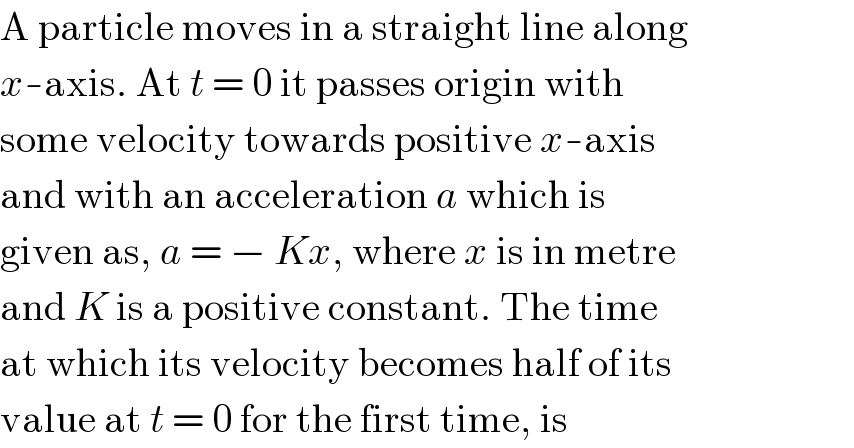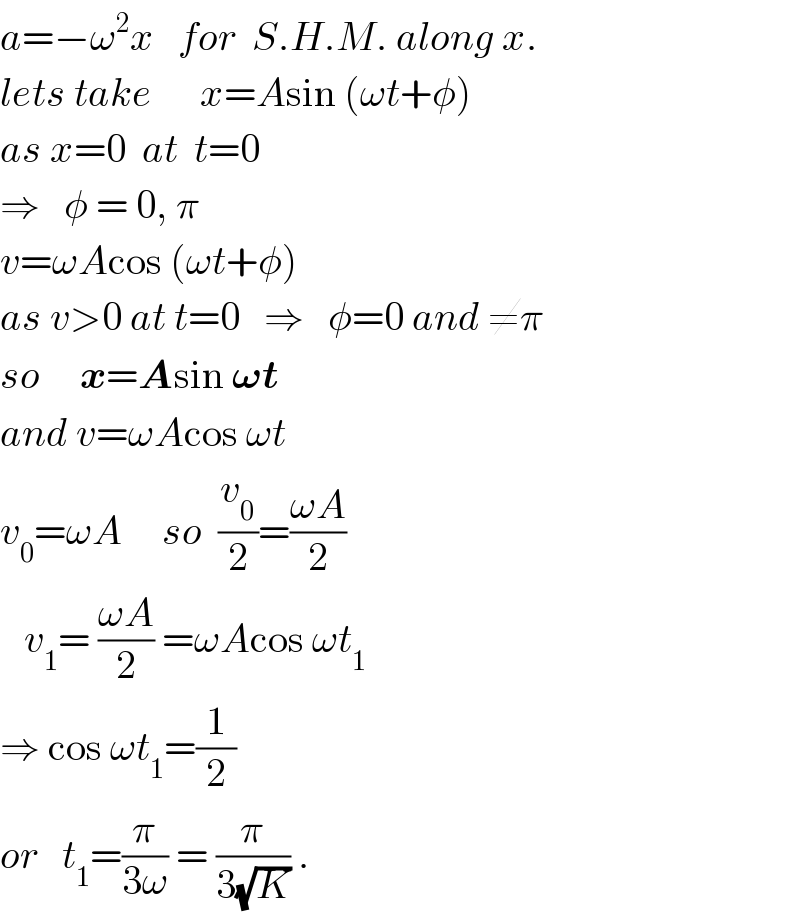
Question Number 24520 by Tinkutara last updated on 19/Nov/17

$$\mathrm{A}\:\mathrm{particle}\:\mathrm{moves}\:\mathrm{in}\:\mathrm{a}\:\mathrm{straight}\:\mathrm{line}\:\mathrm{along} \\ $$$${x}-\mathrm{axis}.\:\mathrm{At}\:{t}\:=\:\mathrm{0}\:\mathrm{it}\:\mathrm{passes}\:\mathrm{origin}\:\mathrm{with} \\ $$$$\mathrm{some}\:\mathrm{velocity}\:\mathrm{towards}\:\mathrm{positive}\:{x}-\mathrm{axis} \\ $$$$\mathrm{and}\:\mathrm{with}\:\mathrm{an}\:\mathrm{acceleration}\:{a}\:\mathrm{which}\:\mathrm{is} \\ $$$$\mathrm{given}\:\mathrm{as},\:{a}\:=\:−\:{Kx},\:\mathrm{where}\:{x}\:\mathrm{is}\:\mathrm{in}\:\mathrm{metre} \\ $$$$\mathrm{and}\:{K}\:\mathrm{is}\:\mathrm{a}\:\mathrm{positive}\:\mathrm{constant}.\:\mathrm{The}\:\mathrm{time} \\ $$$$\mathrm{at}\:\mathrm{which}\:\mathrm{its}\:\mathrm{velocity}\:\mathrm{becomes}\:\mathrm{half}\:\mathrm{of}\:\mathrm{its} \\ $$$$\mathrm{value}\:\mathrm{at}\:{t}\:=\:\mathrm{0}\:\mathrm{for}\:\mathrm{the}\:\mathrm{first}\:\mathrm{time},\:\mathrm{is} \\ $$
Answered by mrW1 last updated on 19/Nov/17

$${a}=\frac{{dv}}{{dt}}={v}\frac{{dv}}{{dx}}=−{Kx} \\ $$$${vdv}=−{Kxdx} \\ $$$$\frac{{v}^{\mathrm{2}} }{\mathrm{2}}=−\frac{{Kx}^{\mathrm{2}} }{\mathrm{2}}+\frac{{C}}{\mathrm{2}} \\ $$$${at}\:{x}=\mathrm{0},\:{t}=\mathrm{0},\:{v}={v}_{\mathrm{0}} \\ $$$$\Rightarrow{C}={v}_{\mathrm{0}} ^{\mathrm{2}} \\ $$$$\Rightarrow{v}^{\mathrm{2}} ={v}_{\mathrm{0}} ^{\mathrm{2}} −{Kx}^{\mathrm{2}} \\ $$$$\Rightarrow{v}=\sqrt{{v}_{\mathrm{0}} ^{\mathrm{2}} −{Kx}^{\mathrm{2}} } \\ $$$$\Rightarrow\frac{{dx}}{{dt}}=\sqrt{{v}_{\mathrm{0}} ^{\mathrm{2}} −{Kx}^{\mathrm{2}} } \\ $$$$\Rightarrow\frac{{dx}}{\sqrt{{v}_{\mathrm{0}} ^{\mathrm{2}} −{Kx}^{\mathrm{2}} }}={dt} \\ $$$$\Rightarrow\frac{{d}\sqrt{{K}}{x}}{\sqrt{{v}_{\mathrm{0}} ^{\mathrm{2}} −\left(\sqrt{{K}}{x}\right)^{\mathrm{2}} }}=\sqrt{{K}}{dt} \\ $$$$\mathrm{sin}^{−\mathrm{1}} \frac{\sqrt{{K}}{x}}{{v}_{\mathrm{0}} }+{C}=\sqrt{{K}}{t} \\ $$$${at}\:{t}=\mathrm{0},\:{x}=\mathrm{0} \\ $$$$\Rightarrow{C}=\mathrm{0} \\ $$$$\Rightarrow{t}=\frac{\mathrm{1}}{\sqrt{{K}}}\:\mathrm{sin}^{−\mathrm{1}} \frac{\sqrt{{K}}{x}}{{v}_{\mathrm{0}} } \\ $$$$\Rightarrow{x}=\frac{{v}_{\mathrm{0}} }{\sqrt{{K}}}\:\mathrm{sin}\:\left(\sqrt{{K}}{t}\right) \\ $$$$\Rightarrow{v}={v}_{\mathrm{0}} \mathrm{cos}\:\left(\sqrt{{K}}{t}\right) \\ $$$$ \\ $$$${for}\:{v}=\frac{{v}_{\mathrm{0}} }{\mathrm{2}} \\ $$$$\frac{{v}_{\mathrm{0}} ^{\mathrm{2}} }{\mathrm{4}}={v}_{\mathrm{0}} ^{\mathrm{2}} −{Kx}^{\mathrm{2}} \\ $$$$\Rightarrow{x}=\frac{\sqrt{\mathrm{3}}{v}_{\mathrm{0}} }{\mathrm{2}\sqrt{{K}}} \\ $$$$\Rightarrow{t}=\frac{\mathrm{1}}{\sqrt{{K}}}\:\mathrm{sin}^{−\mathrm{1}} \left(\frac{\sqrt{{K}}}{{v}_{\mathrm{0}} }×\frac{\sqrt{\mathrm{3}}{v}_{\mathrm{0}} }{\mathrm{2}\sqrt{{K}}}\right) \\ $$$$\Rightarrow{t}=\frac{\mathrm{1}}{\sqrt{{K}}}\:\mathrm{sin}^{−\mathrm{1}} \left(\frac{\sqrt{\mathrm{3}}}{\mathrm{2}}\right)=\frac{\pi}{\mathrm{3}\sqrt{{K}}} \\ $$$$ \\ $$$${or} \\ $$$$\frac{{v}_{\mathrm{0}} }{\mathrm{2}}={v}_{\mathrm{0}} \mathrm{cos}\:\left(\sqrt{{K}}{t}\right) \\ $$$$\Rightarrow\sqrt{{K}}{t}=\frac{\pi}{\mathrm{3}} \\ $$$$\Rightarrow{t}=\frac{\pi}{\mathrm{3}\sqrt{{K}}} \\ $$
Commented by Tinkutara last updated on 20/Nov/17

$$\mathrm{Thank}\:\mathrm{you}\:\mathrm{very}\:\mathrm{much}\:\mathrm{Sir}! \\ $$$$\mathrm{That}'\mathrm{s}\:\mathrm{I}\:\mathrm{want}\:\mathrm{because}\:\mathrm{I}\:\mathrm{had}\:\mathrm{not} \\ $$$$\mathrm{studied}\:\mathrm{SHM}. \\ $$
Answered by ajfour last updated on 20/Nov/17

$${a}=−\omega^{\mathrm{2}} {x}\:\:\:{for}\:\:{S}.{H}.{M}.\:{along}\:{x}. \\ $$$${lets}\:{take}\:\:\:\:\:\:{x}={A}\mathrm{sin}\:\left(\omega{t}+\phi\right) \\ $$$${as}\:{x}=\mathrm{0}\:\:{at}\:\:{t}=\mathrm{0} \\ $$$$\Rightarrow\:\:\:\phi\:=\:\mathrm{0},\:\pi \\ $$$${v}=\omega{A}\mathrm{cos}\:\left(\omega{t}+\phi\right) \\ $$$${as}\:{v}>\mathrm{0}\:{at}\:{t}=\mathrm{0}\:\:\:\Rightarrow\:\:\:\phi=\mathrm{0}\:{and}\:\neq\pi \\ $$$${so}\:\:\:\:\:\boldsymbol{{x}}=\boldsymbol{{A}}\mathrm{sin}\:\boldsymbol{\omega{t}} \\ $$$${and}\:{v}=\omega{A}\mathrm{cos}\:\omega{t} \\ $$$${v}_{\mathrm{0}} =\omega{A}\:\:\:\:\:{so}\:\:\frac{{v}_{\mathrm{0}} }{\mathrm{2}}=\frac{\omega{A}}{\mathrm{2}} \\ $$$$\:\:\:{v}_{\mathrm{1}} =\:\frac{\omega{A}}{\mathrm{2}}\:=\omega{A}\mathrm{cos}\:\omega{t}_{\mathrm{1}} \\ $$$$\Rightarrow\:\mathrm{cos}\:\omega{t}_{\mathrm{1}} =\frac{\mathrm{1}}{\mathrm{2}} \\ $$$${or}\:\:\:{t}_{\mathrm{1}} =\frac{\pi}{\mathrm{3}\omega}\:=\:\frac{\pi}{\mathrm{3}\sqrt{{K}}}\:. \\ $$
Commented by Tinkutara last updated on 20/Nov/17

$$\mathrm{Thank}\:\mathrm{you}\:\mathrm{very}\:\mathrm{much}\:\mathrm{Sir}! \\ $$
Commented by Tinkutara last updated on 20/Nov/17

$$\mathrm{Using}\:\mathrm{SHM},\:\mathrm{I}\:\mathrm{will}\:\mathrm{need}\:\mathrm{it}\:\mathrm{later}. \\ $$
